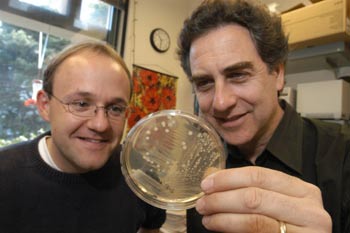This Portnoy has no complaints
The infectious-disease investigator is happy to be at Berkeley, contributing to the work of the campus Health Sciences Initiative
![]()
| 23 April 2003
| |  Laurel Lenz (left), a postdoctoral researcher, and Professor Daniel Portnoy examine a plate of the pathogen Listeria monocytogenes, the troublesome subject of Portnoy's research. Peg Skorpinski photo |
Some of the world’s deadliest diseases are of particular interest to microbiologists working toward understanding a long list of intracellular pathogens, microbes that can spread to other cells without leaving their hosts. It is these pathogens that are responsible for the majority of morbidity and mortality worldwide.
Of particular interest to Daniel Portnoy, a Berkeley professor with joint appointments in molecular and cell biology, public health, and plant and microbial biology, is Listeria, an often food-borne bacterium that he describes as “an intracellular pathogen amenable to analysis.” Listeriosis, most commonly contracted from hot dogs, deli meat, dairy products, and a range of other foods contaminated by Listeria bacteria, infects approximately 2,500 Americans each year. Of those cases, about 500 are deadly.
According to Portnoy, Listeria acts as a model for basic understanding of other, more complex intracellular pathogens, such as those causing AIDS, tuberculosis, and malaria. “Basic understanding could lead to novel and rational approaches to vaccine development and therapeutics in other, more clinically relevant pathogens,” Portnoy explains.
A walk to cherish
Portnoy takes something of a novel approach to the Berkeley campus: He walks here daily from his home in Albany, where he lives with his wife, Suzanne, and his three children, ages 2, 4, and 7. “The only exercise I get is the 25-minute walk to work,” he says a bit ruefully, before adding with obvious sincerity, “I cherish that beautiful walk — it makes me happy each day to have the privilege to live here and work on the Berkeley campus.”
An avid gardener who planted a tree upon the birth of each of his children, Portnoy says he connects to his offspring through his love of nature and biology. But he also enjoys watching sports, and looks forward to taking his children to Cal games when they’re older.
Further cementing his links to the campus community, Portnoy — who came here in 1997 from the Univesity of Pennsylvania medical school — spent a week last summer with his family at the Lair of the Bear, the California Alumni Association’s family camp in the Stanislaus National Forest. There he gave campfire talks on his work on the molecular and cell biology of infectious disease, with examples ranging from food poisoning to bioterrorism. This year, when the family plans to attend the camp again, Portnoy will have another opportunity to share his latest findings.
Those findings may well flow from his research into the intercellular spread of Listeria. Portnoy and his fellow researchers in the Life Sciences Addition use a variety of methods, ranging from bacterial genetics to video microscopy, to study bacterial pathogenesis and observe firsthand the spread of Listeria from one cell to the next without ever leaving the initial host cell. Listeria and other deadly intracellular pathogens like it cause infection by triggering the host cell to digest them. The harmful bacteria first lie in a bubble called a vacuole, then, thanks to a pore-forming toxin called listeriolysin O, break out and enter the rest of the cell.
From there the pathogens hijack the host’s cytoskeleton, which is responsible for motility. The virulent bacteria move through the cell’s guts, or cytosol, to the cell membrane. Without ever leaving the host, the harmful bacteria move into pseudopod-like projections and are ingested by neighboring cells.
The urgency of understanding
Why can’t antibodies be employed to combat Listeria, AIDS, or other deadly intracellular pathogens? According to Portnoy, antibodies are useless in curing these infections because the harmful bacteria remain inside host cells, and are therefore never exposed to this arm of the body’s immune-response mechanisms. This phenomenon makes it even more important to understand fully how cellular pathogens operate and spread, so that cures and therapeutics might be found for some of the world’s deadliest diseases.
It also makes the urgency of understanding Listeria and its ilk a top priority for Portnoy, one of hundreds of campus researchers who are part of the Berkeley Health Sciences Initiative, which aims to find answers to some of the most challenging international health problems.
Portnoy’s excitement about the initiative’s prospects is palpable when he refers to “the many bridges it will build” among the diverse health-related research projects now under way on and around the campus, involving a wide range of departments. That interplay is another plus to working at Berkeley, says Portnoy, who appreciates the opportunity to work with “colleagues who are extremely strong in their own areas, leading to a lot of interactions without barriers.”

